College Or University Transfer Letter
[Your Name]
[Your Address]
[City, State, Zip Code]
[Email Address]
[Phone Number]
[Today's Date]
[Admissions Office]
[College/University Name]
[Address]
[City, State, Zip Code]
Dear Admissions Committee,
I hope this letter finds you well. I am writing to express my strong interest in transferring to [College/University Name] for the [semester/year] in pursuit of [desired major or area of study]. Currently, I am enrolled at [Current College/University Name] and have completed [number of credits completed] credits towards my [current major or field of study]. After thorough research and consideration, I am convinced that [College/University Name] offers the ideal academic environment and opportunities for me to achieve my educational and career goals.
The decision to transfer has not been taken lightly. My experiences at my current institution have been valuable, and I have learned a great deal. However, while reflecting on my academic journey, I have come to realize that [College/University Name] aligns better with my academic interests and offers a more comprehensive program in my chosen field. The reputation of your faculty and resources, as well as the wide range of extracurricular activities available, make [College/University Name] an ideal place for me to continue my education.
I have thoroughly researched the transfer admissions requirements and have taken all necessary steps to ensure I meet the criteria for admission. Enclosed with this letter, you will find all the required documents, including:
1. Completed Transfer Application Form
2. Official Transcripts from [Current College/University Name]
3. Course Descriptions and Syllabi of completed courses
4. Letters of Recommendation from [professors/academic advisors]
5. Personal Statement outlining my reasons for transferring and my academic and career goals.
I am eager to contribute to the vibrant academic community at [College/University Name] and to learn from the diverse perspectives of both faculty and fellow students. The outstanding reputation of [College/University Name] in [your desired major or area of study] will undoubtedly enhance my educational experience and provide me with the knowledge and skills needed to excel in my future career.
If there is an opportunity to visit the campus and meet with an admissions counselor or academic advisor, I would be thrilled to do so. I believe a personal interaction would further demonstrate my commitment to becoming a part of [College/University Name]'s esteemed student body.
Thank you for considering my application. I understand the competitive nature of transfer admissions and sincerely hope that my academic achievements and passion for learning will make me a strong candidate. I look forward to the possibility of joining [College/University Name] and contributing to its academic community.
If you require any further information or have any questions, please feel free to contact me at [your email address] or [your phone number]. I eagerly await your positive response.
Sincerely,
[Your Name]
Student Request for Transfer to Another University - Formal
Subject: Application for Transfer to [University Name]
Dear Admissions Committee,
I am writing to formally request a transfer from [Current University Name] to [Target University Name] for the [semester/quarter] term of [year]. I am currently a [year] student majoring in [major] with a cumulative GPA of [GPA].
After careful consideration of my academic and career goals, I have determined that [Target University Name] offers the specialized programs and resources that align more closely with my educational objectives. Specifically, I am drawn to your [specific program/department/research opportunities] which are not available at my current institution.
During my time at [Current University], I have completed [number] credit hours and maintained strong academic standing. I have been actively involved in [relevant activities, clubs, or achievements], which have prepared me well for the rigorous academic environment at your institution.
I have enclosed my official transcripts, letters of recommendation, and all required application materials. I am committed to contributing positively to the academic community at [Target University Name] and believe that this transfer will significantly enhance my educational experience.
Thank you for considering my application. I look forward to the opportunity to continue my education at your esteemed institution.
Sincerely,
[Your Name]
[Student ID]
[Contact Information]
Internal Transfer Request Between Colleges Within Same University - Professional
Subject: Request for Internal Transfer to [College/School Name]
Dear Dean [Name] and Transfer Committee,
I am currently enrolled in the [Current College] as a [year] student and am writing to request an internal transfer to the [Target College] effective [semester/year]. My student ID is [ID number].
Since beginning my studies in [current major], I have discovered a stronger passion and aptitude for [new field of study]. This realization came through [specific experiences, courses, or activities]. My current GPA of [GPA] demonstrates my academic commitment and ability to succeed in challenging coursework.
The [Target College] offers courses and faculty expertise in [specific areas] that are essential to my career aspirations in [field/industry]. I have already completed [number] credits that will transfer toward the requirements of the [new major] program, including [relevant courses].
I have met with advisors from both colleges to ensure a smooth transition and have created a preliminary academic plan that will allow me to complete degree requirements within [timeframe]. I am fully prepared to meet any additional prerequisites or conditions required for this transfer.
I respectfully request your favorable consideration of my transfer application and am available to discuss my academic plans in greater detail at your convenience.
Respectfully,
[Your Name]
[Current Major]
[Contact Information]
Transfer Request Due to Financial Constraints - Heartfelt
Subject: Transfer Application - Financial Circumstances
Dear Admissions Office,
I hope this message finds you well. I am writing to apply for transfer admission to [University Name] for the [semester] semester, driven by circumstances that require me to make a difficult but necessary decision about my education.
I am currently a [year] student at [Current University] majoring in [major], where I have maintained a [GPA] GPA while working part-time to support my education. Despite my deep appreciation for the education I have received, the financial burden of attending [Current University] has become unsustainable for my family.
[University Name] offers not only academic excellence in [field of study] but also the opportunity to continue my education while remaining closer to home, significantly reducing living expenses. The combination of lower tuition costs and the ability to live with family would allow me to focus more fully on my studies without the constant stress of financial uncertainty.
I am passionate about completing my degree in [major] and am committed to contributing meaningfully to your campus community. I have researched your programs extensively and am excited about the opportunities available through your [specific department or program].
I have included all necessary documentation with this application and am hopeful for the opportunity to continue my educational journey at your institution. Thank you for considering my situation with understanding and compassion.
With sincere appreciation,
[Your Name]
[Contact Information]
Transfer Request Due to Relocation - Simple
Subject: Transfer Application Due to Family Relocation
Dear Admissions Team,
I am applying for transfer admission to [University Name] for the [semester] term due to my family's relocation to [city/state]. I am currently a [year] student at [Current University] with a major in [major] and a GPA of [GPA].
My family is moving to [location] because of [parent's job transfer/family circumstances], making it impractical for me to continue at my current institution. I have thoroughly researched [University Name] and am impressed by your [specific program or department] offerings.
I have completed [number] credit hours and am on track to graduate in [expected graduation date]. I am eager to continue my studies without interruption and believe [University Name] will provide an excellent environment to complete my degree.
All required documents, including transcripts and test scores, are enclosed with this application. I am available for an interview at your convenience and would be happy to provide any additional information needed.
Thank you for your consideration.
Best regards,
[Your Name]
[Student ID]
[Phone/Email]
Transfer Recommendation Letter from Professor - Professional
Subject: Letter of Recommendation for [Student Name] - Transfer Application
Dear Admissions Committee,
I am writing to enthusiastically recommend [Student Name] for transfer admission to [University Name]. I have had the pleasure of teaching [him/her/them] in [course names] during [his/her/their] time at [Current University], where I serve as [title] in the [Department] Department.
[Student Name] has consistently demonstrated exceptional academic ability, intellectual curiosity, and dedication to [field of study]. In my [course name], [he/she/they] earned one of the highest grades in the class and produced work that showed remarkable [specific qualities]. [His/Her/Their] analytical skills and creative approach to problem-solving set [him/her/them] apart from peers.
Beyond academics, [Student Name] has shown maturity and professionalism in all interactions. [He/She/They] actively participates in class discussions, helps fellow students, and shows genuine passion for learning. [His/Her/Their] decision to transfer to [University Name] is well-considered and motivated by [specific academic or career goals].
I am confident that [Student Name] possesses the academic preparation, personal qualities, and motivation to thrive at your institution. [He/She/They] will be an asset to your academic community, and I give [him/her/them] my highest recommendation without reservation.
Please feel free to contact me if you require any additional information.
Sincerely,
[Professor Name]
[Title]
[Department]
[University Name]
[Contact Information]
Transfer Credit Evaluation Request Email - Professional
Subject: Transfer Credit Evaluation Inquiry
Dear Registrar's Office,
I am an incoming transfer student who has been admitted to [University Name] for the [semester] semester (Student ID: [ID if assigned]). I am writing to request information about the transfer credit evaluation process and to inquire about the status of my credit transfer.
I have completed [number] credit hours at [Previous Institution Name], including courses in [major areas]. I submitted my official transcripts on [date] and would like to understand:
How many of my credits have been accepted for transfer
Which courses satisfy general education or major requirements
Whether any courses require additional documentation or course descriptions
The timeline for receiving my complete transfer credit evaluation
Understanding my transfer credit status will help me plan my course schedule and graduation timeline more effectively. I have attached unofficial copies of my transcripts along with course descriptions for your reference, if needed.
Could you please provide guidance on the next steps in this process? I am happy to supply any additional documentation that might be required.
Thank you for your assistance with this matter.
Best regards,
[Your Name]
[Previous Institution]
[Email Address]
[Phone Number]
Appeal Letter for Denied Transfer Application - Serious
Subject: Appeal of Transfer Admission Decision - [Your Name]
Dear Admissions Appeals Committee,
I am writing to formally appeal the decision to deny my transfer application to [University Name] for the [semester] term. While I understand that admission is highly competitive, I believe there are compelling circumstances and information that warrant reconsideration of my application.
Since submitting my original application, several significant developments have occurred. First, I have completed [additional coursework] with grades of [grades], raising my GPA from [old GPA] to [new GPA]. Second, [other significant achievement or circumstance that has changed].
I want to address what may have been perceived as weaknesses in my original application. [Explain specific circumstances that may have affected your academic record, such as illness, family emergency, or other challenges]. These circumstances are no longer factors, and my recent academic performance demonstrates my true capabilities and commitment.
[University Name] remains my first choice because of [specific reasons related to program, faculty, research, or other opportunities]. I have taken concrete steps to prepare for success at your institution, including [specific actions taken].
I have enclosed updated transcripts, an additional letter of recommendation from [source], and documentation supporting the circumstances I have described. I respectfully request that you reconsider my application in light of this new information.
I am grateful for your time and thoughtful consideration of my appeal.
Respectfully submitted,
[Your Name]
[Application ID]
[Contact Information]
Transfer Acceptance Confirmation Email - Professional
Subject: Acceptance of Transfer Admission Offer - [Your Name]
Dear Admissions Office,
I am delighted to accept the offer of transfer admission to [University Name] for the [semester] semester. Thank you for this wonderful opportunity to continue my education at your esteemed institution.
As requested, I confirm my intent to enroll as a transfer student in the [College/School Name] majoring in [major]. I understand that I must complete the following steps by [deadline]:
Submit enrollment deposit of [amount]
Complete housing application (if applicable)
Submit final official transcripts from [Current University]
Complete orientation registration
[Any other required steps]
I will ensure all requirements are fulfilled by the specified deadlines. Please let me know if there are any additional forms or information needed from me at this time.
I am excited to join the [University Name] community and look forward to contributing to campus life while pursuing my academic goals.
Thank you again for this opportunity.
Sincerely,
[Your Name]
[Student ID Number]
[Contact Information]
What is a College or University Transfer Letter and Why is it Needed
A college or university transfer letter is a formal document requesting admission to a different institution or different academic program within the same institution. These letters serve multiple critical purposes:
- Communicating Intent: Formally notifies institutions of your desire to transfer and demonstrates serious commitment to the process
- Explaining Circumstances: Provides context for your transfer decision, whether academic, financial, personal, or professional
- Showcasing Qualifications: Highlights your academic achievements, extracurricular involvement, and readiness for the new institution
- Differentiating Your Application: Distinguishes transfer students from first-year applicants by addressing unique transfer-specific concerns
- Building Your Case: Articulates why the target institution is the right fit for your specific educational and career goals
- Facilitating Administrative Processes: Initiates official procedures for credit evaluation, admission review, and enrollment management
When Should You Send a Transfer Letter
Transfer letters become necessary in various situations and timing is crucial for success:
- Academic Mismatch: When your current program lacks the specialization, research opportunities, or faculty expertise you need
- Financial Hardship: When tuition costs or living expenses become unsustainable and a more affordable option exists
- Geographic Relocation: When family moves or personal circumstances require you to attend school in a different location
- Program Availability: When your desired major or minor is not offered at your current institution
- Academic Performance Issues: When you need a fresh start due to past academic difficulties (with proper explanation)
- Better Opportunities: When another institution offers superior resources, internship connections, or career placement in your field
- Personal or Family Circumstances: When health issues, family responsibilities, or other personal factors necessitate a change
- Competitive Program Access: When you've developed competitive credentials to apply to more selective institutions
- Change in Career Goals: When your professional aspirations shift and require different academic preparation
- Campus Culture Fit: When the social, cultural, or academic environment isn't conducive to your success
Who Should Write or Submit These Letters
Different individuals may be responsible for transfer correspondence depending on the letter type:
- The Student: Most transfer application letters, appeals, and acceptance confirmations come directly from the student
- Faculty Members: Professors write recommendation letters supporting a student's transfer application
- Academic Advisors: May provide supporting documentation or official correspondence regarding a student's academic standing
- Registrar's Office: Handles official communications about credit transfer and transcript evaluation
- Department Chairs: Sometimes write letters supporting internal transfers between programs or departments
- Parents or Guardians: Rarely appropriate, except when providing financial documentation or in cases involving dependent students under 18
- Current Institution Officials: May need to provide official withdrawal or release documentation
To Whom Should Transfer Letters Be Addressed
Proper addressing ensures your letter reaches the right decision-makers:
- Transfer Admissions Committee: The primary audience for most transfer applications at the target institution
- Dean of Admissions: For formal transfer requests or appeals, especially at smaller institutions
- Specific College or School Dean: For internal transfers between different colleges within the same university
- Department Chair: When transferring between departments or seeking admission to competitive majors
- Registrar's Office: For credit evaluation inquiries and transcript-related correspondence
- Appeals Committee: Specifically for appealing denied transfer applications
- Financial Aid Office: When financial circumstances are a factor and you need information about aid availability
- Academic Advisors: For preliminary consultations and guidance before formal application
- Housing Office: When transfer admission includes residential considerations
Requirements and Prerequisites Before Writing Your Transfer Letter
Successful transfer letters require thorough preparation and documentation:
- Research Target Institution: Understand admission requirements, deadlines, transfer credit policies, and program specifics
- Academic Records Review: Obtain unofficial transcripts to assess your GPA and completed coursework
- Credit Hour Verification: Confirm you meet minimum credit hour requirements (typically 12-30 credits completed)
- Prerequisites Check: Ensure you've completed or are enrolled in required courses for your intended major
- Application Portal Access: Create accounts and familiarize yourself with the transfer application system
- Letters of Recommendation: Identify and contact 2-3 professors or advisors who can write strong recommendations
- Personal Statement Draft: Develop compelling reasons for transferring beyond simple dissatisfaction
- Financial Planning: Understand costs, aid availability, and scholarship opportunities at the target institution
- Course Catalog Comparison: Review how your completed courses align with target institution requirements
- Meeting with Current Advisor: Discuss transfer implications and obtain necessary signatures or releases
- Standardized Test Scores: Verify whether SAT/ACT scores are required for transfer applicants
- Application Fee Preparation: Ensure you can pay required application fees or obtain fee waivers
How to Write and Send Your Transfer Letter
Follow this strategic approach for maximum effectiveness:
- Start Early: Begin researching and writing 3-6 months before intended enrollment term
- Draft Multiple Versions: Tailor each letter specifically to the institution rather than using generic templates
- Open Strongly: Begin with a clear statement of intent and the specific program you're applying to
- Explain Positively: Frame transfer reasons in terms of seeking opportunities rather than escaping problems
- Demonstrate Knowledge: Reference specific programs, professors, research opportunities, or resources at the target institution
- Address Academic Record: Explain your GPA, highlighting strengths and addressing any weaknesses contextually
- Show Growth: Emphasize how you've matured academically and personally since starting college
- Connect Goals: Clearly link the target institution's offerings to your specific career and academic objectives
- Provide Evidence: Include concrete examples of achievements, involvement, and academic success
- Professional Tone: Maintain formal, respectful language while showing genuine enthusiasm
- Proofread Rigorously: Eliminate all grammatical errors, typos, and awkward phrasing
- Seek Feedback: Have professors, advisors, or writing center staff review your letter
- Follow Submission Guidelines: Submit through the proper channel (online portal, email, or mail) by deadlines
- Keep Copies: Maintain records of all correspondence and submitted materials
Elements and Structure of an Effective Transfer Letter
Comprehensive transfer letters should include these key components:
- Clear Subject Line: For emails, use specific, descriptive subject lines with your name and purpose
- Formal Salutation: Address recipients appropriately using proper titles
- Opening Paragraph: State your current institution, year, major, and transfer intent immediately
- Academic Background: Include GPA, credit hours completed, and relevant coursework
- Transfer Rationale: Explain compelling, specific reasons for transferring (2-3 paragraphs)
- Institutional Knowledge: Demonstrate research about target institution's specific programs and opportunities
- Personal Qualifications: Highlight achievements, extracurricular activities, and unique contributions you'll bring
- Academic Goals: Articulate short-term and long-term educational and career objectives
- Connection Statement: Explicitly link how the target institution enables achieving your goals
- Supporting Documentation Reference: Mention enclosed or attached transcripts, recommendations, test scores
- Call to Action: Politely indicate your availability for interviews or to provide additional information
- Professional Closing: Use appropriate sign-offs like "Sincerely" or "Respectfully"
- Contact Information: Include phone number, email, and student ID if applicable
- Attachments: Include all required documents properly labeled and organized
Formatting Guidelines for Transfer Letters
Proper formatting enhances professionalism and readability:
- Length: Keep application letters to 1-2 pages (400-600 words); recommendation letters 1 page; inquiries brief
- Font: Use professional fonts like Times New Roman, Arial, or Calibri in 11-12 point size
- Spacing: Single-space with double spacing between paragraphs for printed letters
- Margins: Maintain 1-inch margins on all sides
- Alignment: Left-align all text except for date and closing in traditional business letter format
- Tone: Formal and professional for applications; slightly warmer for acceptances; serious for appeals
- Paragraph Length: Keep paragraphs 4-6 sentences; avoid dense blocks of text
- Digital Submission: Use PDF format unless otherwise specified to preserve formatting
- File Naming: Use clear names like "LastName_FirstName_TransferLetter.pdf"
- Email Etiquette: Use professional email addresses; write descriptive subject lines; maintain formal tone
- Attachments Organization: Clearly label all attachments and reference them in the letter body
- Signature: Include typed name with handwritten signature for printed letters; typed name only for emails
What to Do After Sending Your Transfer Letter
Post-submission actions are crucial for maintaining momentum:
- Confirm Receipt: Check that your application was received and is complete within 3-5 business days
- Monitor Application Portal: Regularly log in to check for updates, requests for additional materials, or status changes
- Respond Promptly: If institutions request additional information or documentation, provide it within 24-48 hours
- Follow Up Appropriately: Send a brief inquiry if you haven't received confirmation after one week
- Maintain Current Academic Performance: Continue strong performance at your current institution as final transcripts will be reviewed
- Keep Copies: Save all correspondence, confirmations, and submitted materials in organized files
- Prepare for Interviews: If interview opportunities arise, research and practice responses to common transfer questions
- Track Deadlines: Monitor decision notification dates and enrollment deposit deadlines
- Plan for Multiple Outcomes: Prepare contingency plans for acceptance, rejection, or waitlist scenarios
- Submit Final Transcripts: After acceptance, ensure official final transcripts are sent by required deadlines
- Complete Enrollment Steps: Follow through with all required forms, deposits, housing applications, and orientation registration
- Notify Current Institution: Submit formal withdrawal or transfer paperwork according to their policies
- Thank Recommenders: Send thank-you notes to professors and advisors who supported your application
Common Mistakes to Avoid When Writing Transfer Letters
Avoid these pitfalls that weaken transfer applications:
- Being Vague About Reasons: Generic statements like "better education" without specific institutional knowledge
- Negative Focus: Complaining about current institution rather than emphasizing positive goals
- Lack of Research: Failing to reference specific programs, faculty, or opportunities at target institution
- Unrealistic Expectations: Assuming all credits will transfer or that transfer is guaranteed
- Poor Timing: Missing deadlines or applying too late for competitive programs
- Grammatical Errors: Typos, spelling mistakes, or poor writing quality that suggests carelessness
- Too Much Information: Including irrelevant personal details or excessive explanation of every life circumstance
- Generic Letters: Using identical letters for multiple institutions without customization
- Weak Academic Justification: Not adequately explaining how the new institution serves your academic goals
- Ignoring Weaknesses: Failing to address obvious issues like low GPA or academic probation
- Overconfidence: Presumptive tone suggesting admission is deserved rather than requested
- Incomplete Applications: Missing required documents, signatures, or forms
- Inappropriate Tone: Too casual, demanding, or emotional language in formal correspondence
- Forgetting Follow-Through: Not completing enrollment steps after acceptance
- Burning Bridges: Leaving current institution on poor terms without proper withdrawal procedures
Advantages and Disadvantages of Transferring Universities
Consider these factors when deciding whether to transfer:
Advantages:
- Access to specialized programs, majors, or research opportunities unavailable at current institution
- Potential cost savings through lower tuition or better financial aid packages
- Improved academic fit with faculty expertise aligned to your interests
- Enhanced career prospects through stronger alumni networks and employer recruiting
- Better campus culture fit socially, culturally, or academically
- Geographic advantages including proximity to family, internship opportunities, or preferred location
- Fresh start academically if previous performance doesn't reflect your capabilities
- Exposure to different teaching methods, perspectives, and academic environments
Disadvantages:
- Loss of transfer credits, potentially extending time to graduation
- Social disruption from leaving established friendships and campus connections
- Academic adjustment challenges including different teaching styles and expectations
- Financial implications including application fees, moving costs, and potential loss of scholarships
- Starting over with extracurricular involvement and leadership positions
- Missing out on senior-year benefits at original institution
- Uncertainty about acceptance outcomes and credit transfer evaluation
- Potential impact on graduate school applications if transcript shows multiple institutions
Tips and Best Practices for Successful Transfer Applications
Maximize your transfer success with these strategies:
- Apply to Multiple Schools: Submit applications to 3-5 target institutions to increase acceptance odds
- Time Your Transfer Strategically: Transferring after sophomore year typically results in better credit transfer
- Build Relationships: Develop strong connections with professors who can write compelling recommendations
- Maintain High GPA: Aim for 3.5+ GPA as transfer admission is often more competitive than freshman admission
- Document Everything: Keep course syllabi, descriptions, and samples of work for credit evaluation appeals
- Visit Campuses: If possible, visit target institutions to demonstrate interest and gather specific details
- Attend Transfer Events: Participate in virtual or in-person transfer student information sessions
- Connect with Transfer Coordinators: Build relationships with admission counselors who specialize in transfers
- Articulate Fit Specifically: Use institutional language and reference specific courses, professors, or programs by name
- Address Red Flags Proactively: If you have academic difficulties, explain them honestly with context
- Leverage Transfer Pathways: Research articulation agreements between community colleges and universities
- Show Continued Growth: Demonstrate upward grade trends and increased involvement over time
- Be Authentic: Write in your genuine voice rather than trying to sound overly academic
- Plan Course Selection: Take transferable courses that satisfy general education requirements
- Start Networking Early: Connect with current students or alumni from target institutions through LinkedIn or student groups
How Transfer Letters Compare to Other Application Materials
Understanding distinctions helps you craft appropriate correspondence:
- Transfer vs. Freshman Applications: Transfer letters emphasize college experience and reasons for changing institutions; freshman applications focus on high school achievements and potential
- Transfer Letter vs. Personal Statement: Transfer letters are often shorter and more specifically focused on transfer rationale; personal statements broadly explore identity and experiences
- Application Letter vs. Inquiry Email: Formal applications are comprehensive and submitted through official channels; inquiries are brief questions sent to specific offices
- Student Letter vs. Recommendation Letter: Student letters advocate for themselves; recommendations provide third-party validation from faculty
- Transfer Appeal vs. Initial Application: Appeals address specific denial reasons with new evidence; initial applications present original candidacy
- Acceptance Confirmation vs. Intent to Enroll Form: Confirmations are formal letters; intent forms are administrative documents
- Internal vs. External Transfer Letters: Internal transfers focus on program fit within the institution; external transfers justify institutional change
Frequently Asked Questions About Transfer Letters
How long should my transfer letter be? Aim for 400-600 words or 1-2 pages. Be comprehensive but concise, focusing on the most compelling reasons and qualifications.
Should I explain why I'm leaving my current school? Yes, but frame it positively. Focus on what you're seeking rather than what you're escaping. Emphasize opportunity over dissatisfaction.
Do I need to submit transfer letters if applying through Common App? The Common App has a transfer essay section. Additional letters may be needed for specific programs or circumstances.
Can I transfer after just one semester? Policies vary by institution. Many require 12-30 completed credit hours, which typically means at least one full year.
How do I address a low GPA in my transfer letter? Acknowledge it briefly, provide context if relevant circumstances existed, and emphasize recent improvement and future commitment.
Should I mention specific professors I want to work with? Absolutely. This demonstrates research and genuine interest in the academic program.
Is it appropriate to discuss financial reasons for transferring? Yes, when relevant. Frame it professionally, focusing on how affordability enables you to focus on academics.
How many schools should I apply to transfer? Apply to 3-5 institutions including reach, match, and safety options to maximize acceptance likelihood.
Do transfer letters require signatures? Student application letters should be signed. Recommendation letters require professor signatures. Check specific requirements.
Should I send thank-you letters after acceptance? While not required, a brief thank-you email to your admission counselor is a nice professional touch.

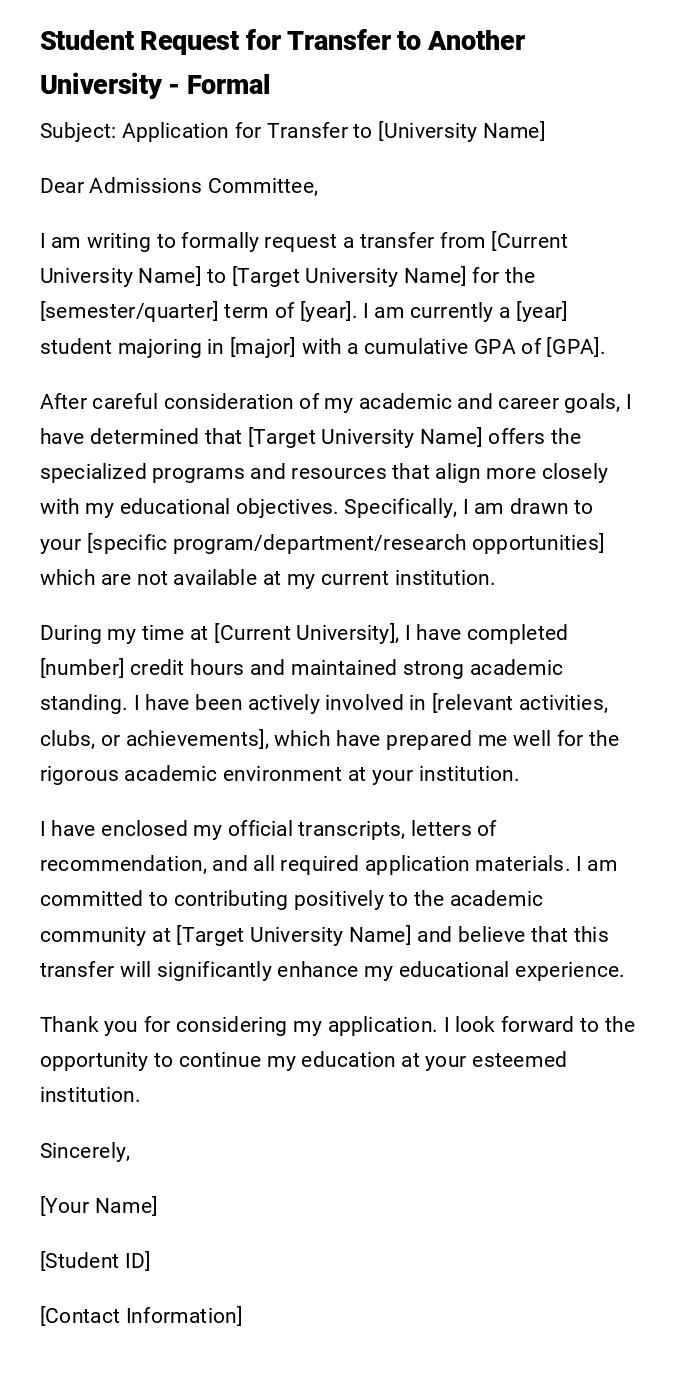
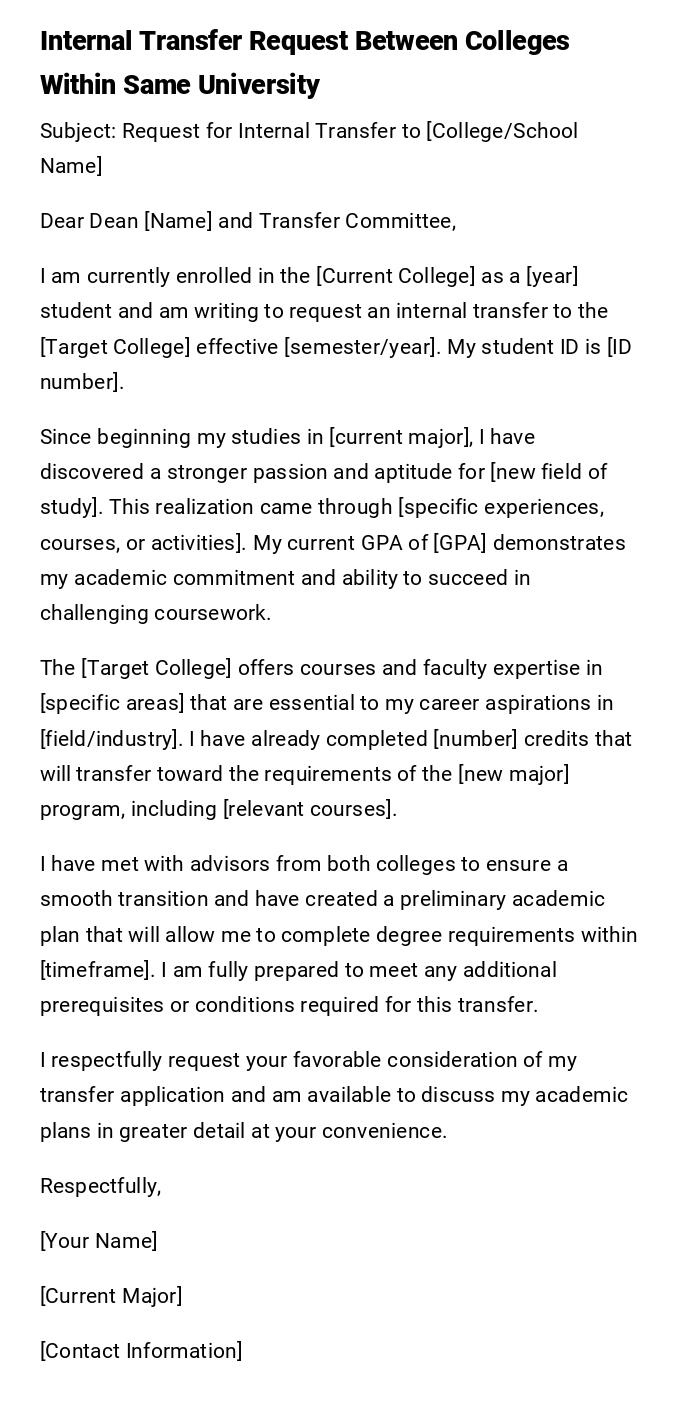
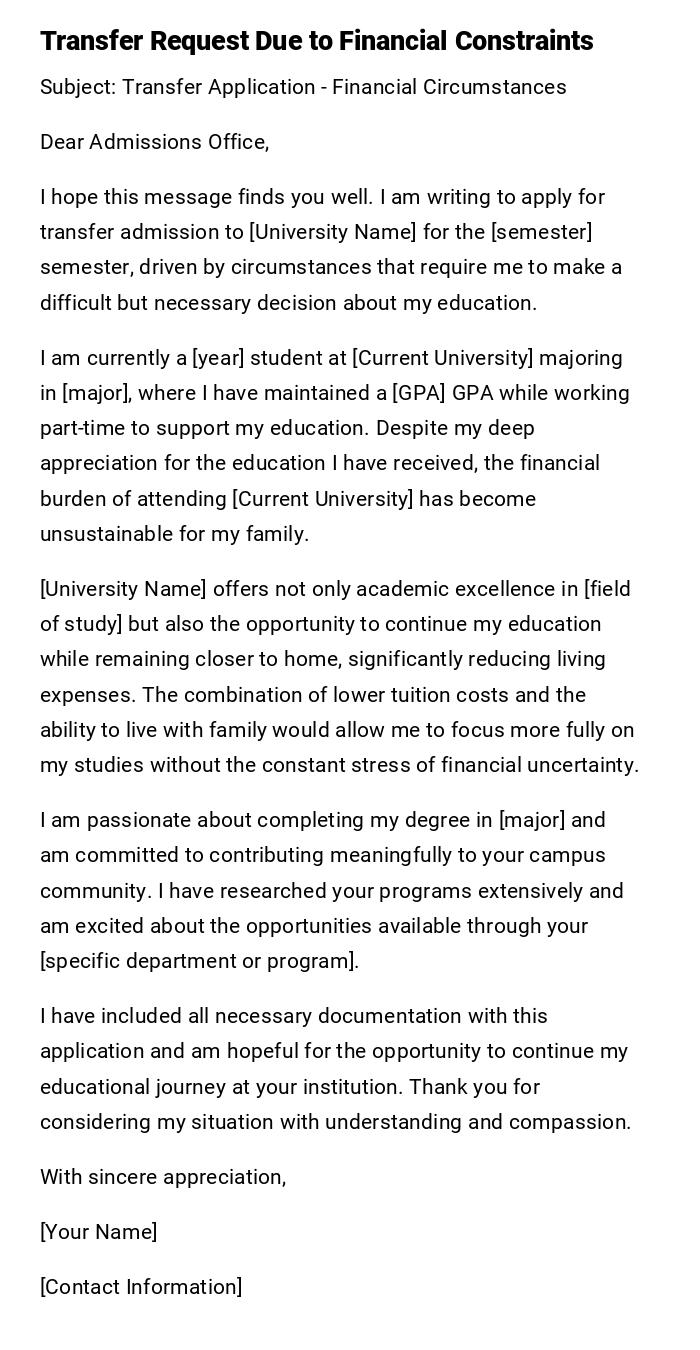
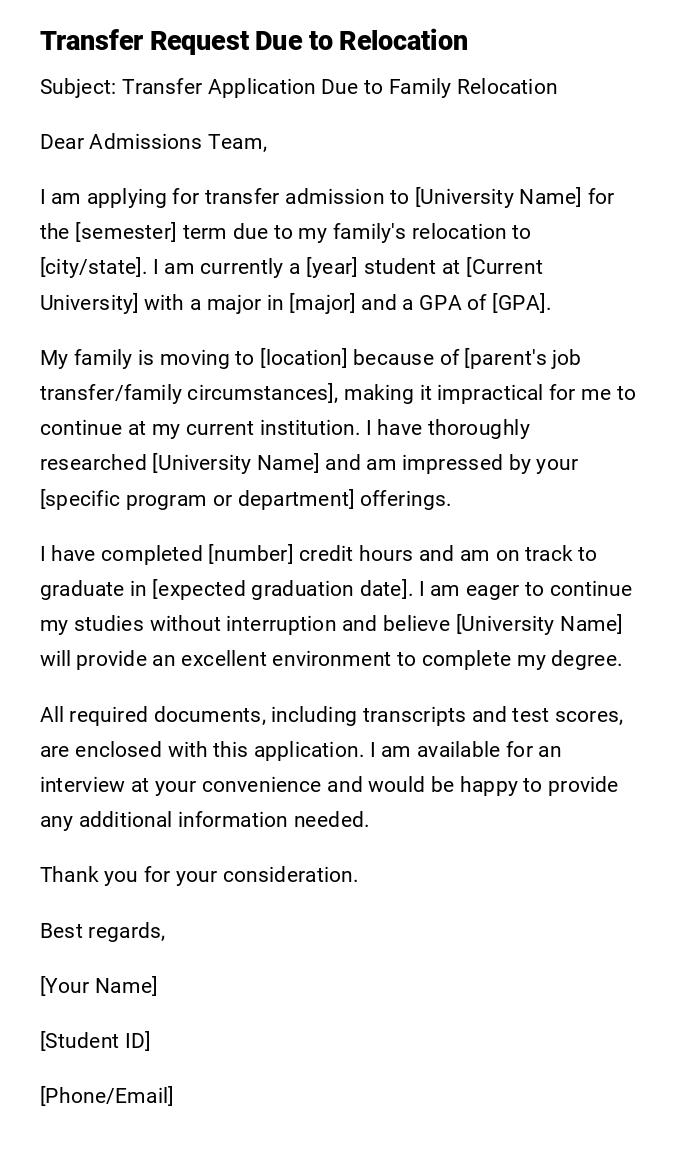
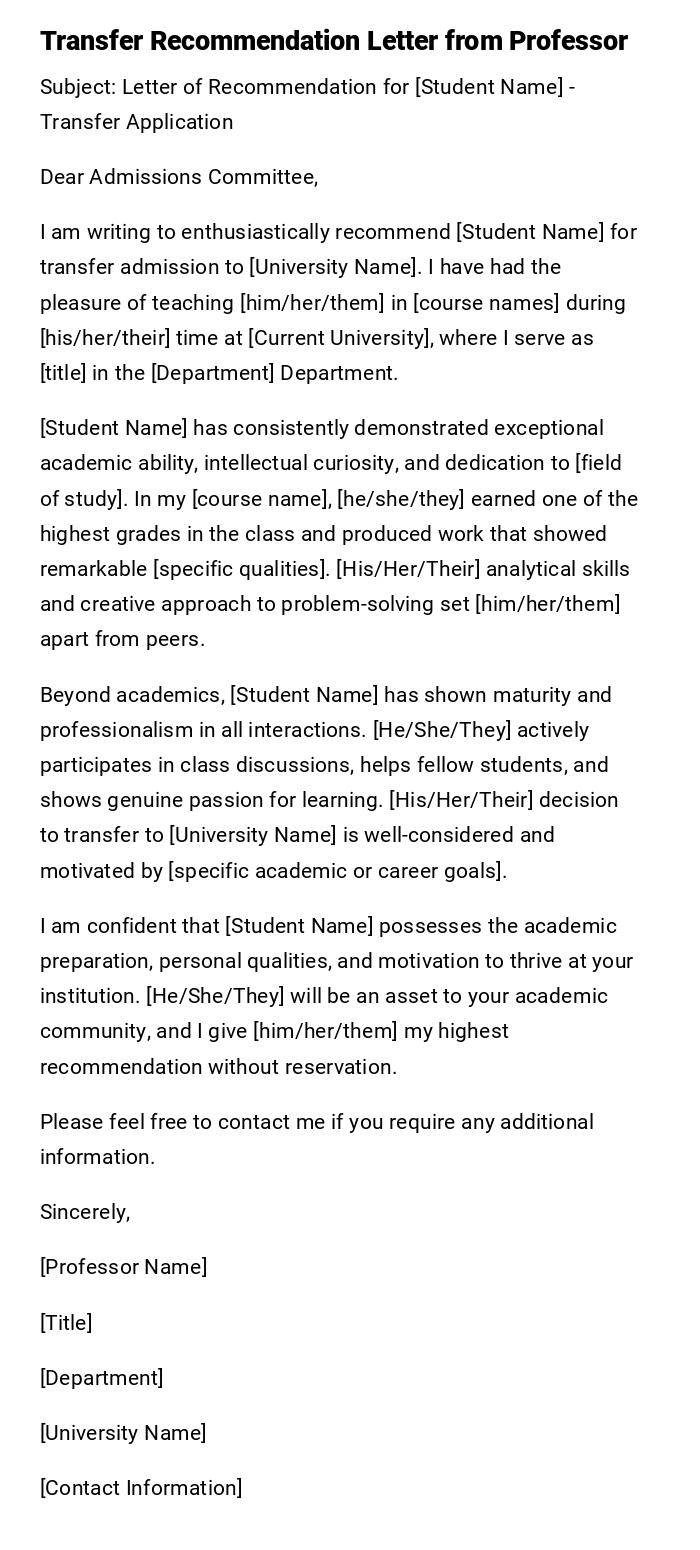
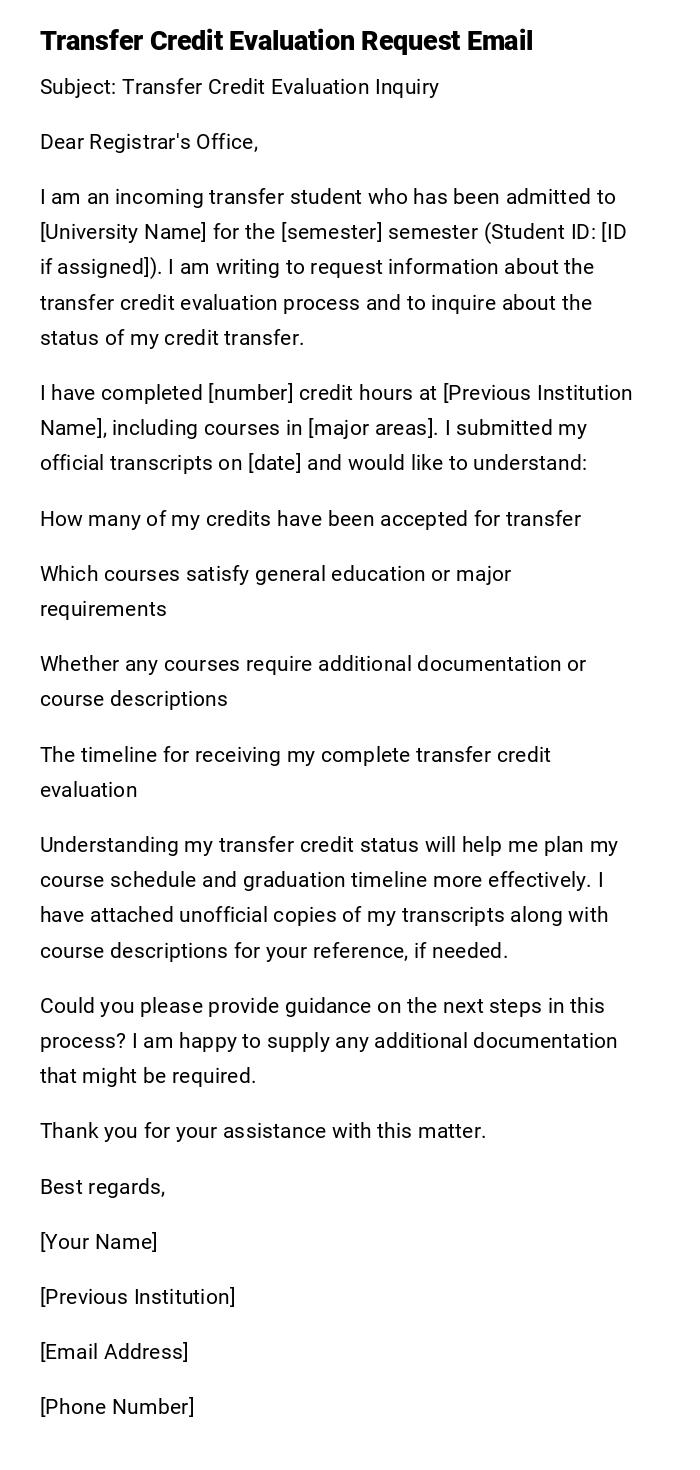
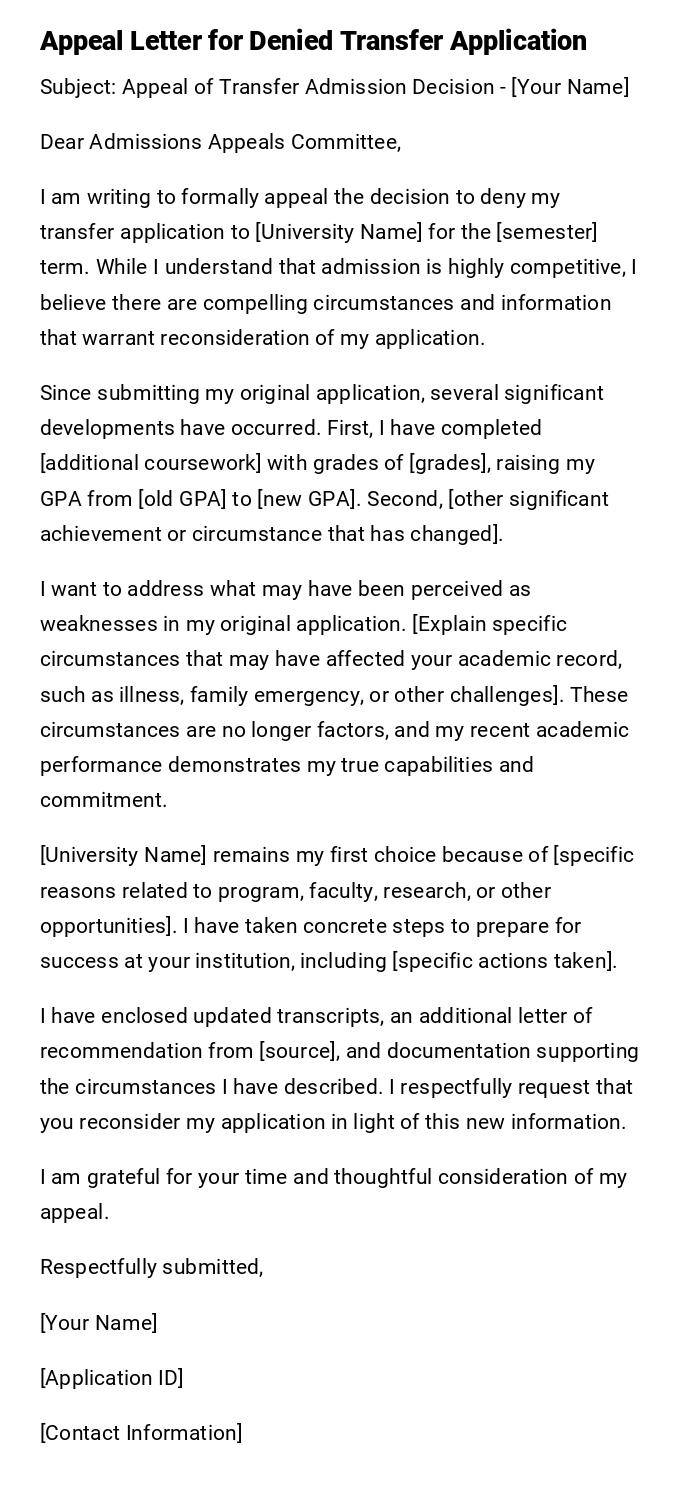
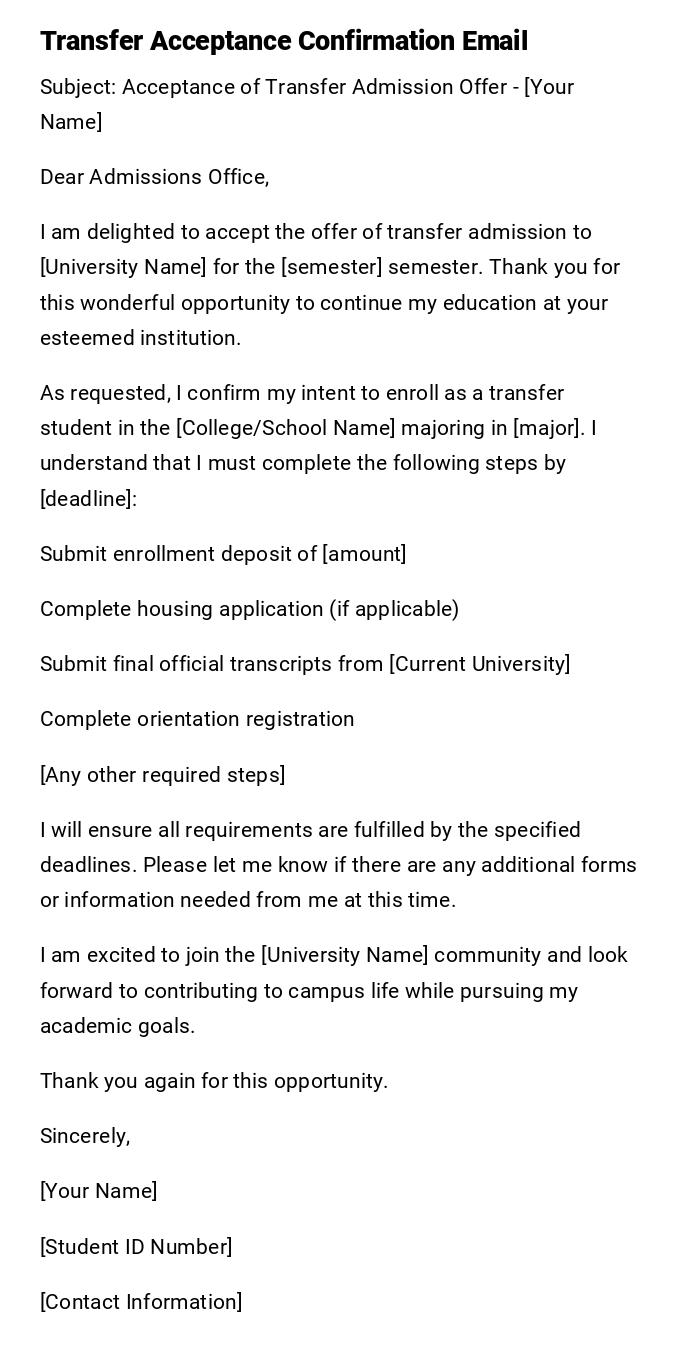

 Download Word Doc
Download Word Doc
 Download PDF
Download PDF